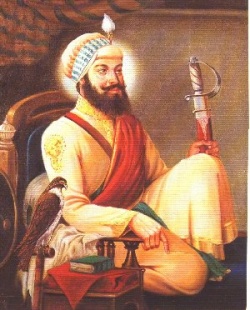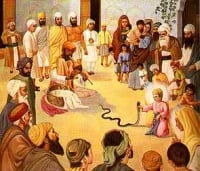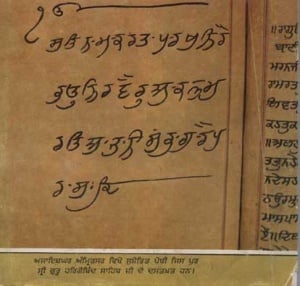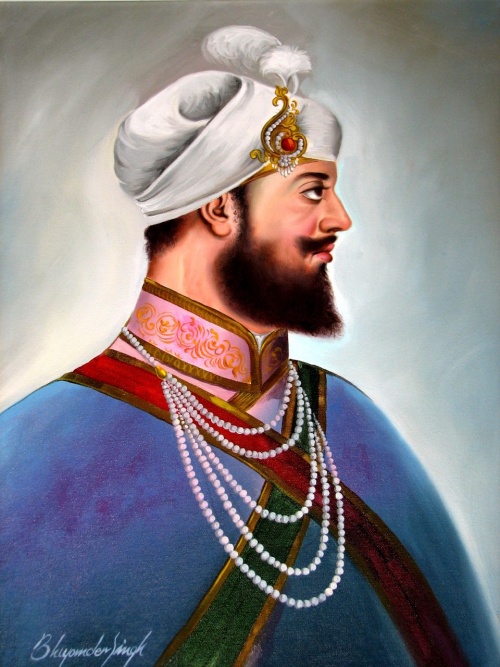Guru Har Gobind
| Guru Har Gobind (1595 to 1644) | |
| Full Name : | Har Gobind |
| Personal Details | |
| Birth : | Monday, 19 June 1595, Guru ki Vadali in Dist. Amritsar |
| Guruship : | Wednesday, 11 June 1606 |
| Joti Jot : | Tuesday, 19 March 1644 |
| Family | |
| Parents : | Guru Arjan Dev & Mata Ganga |
| Brother/Sisters : | -N.A- |
| Spouse : | Mata Nanaki, Mata Mahadevi,Mata Damodari |
| Children : | Sons - Baba Gurditta, Baba Suraj Mal, Baba Ani Rai, Baba Atal Rai & Guru Tegh Bahadur Daughter - Bibi Biro |
| Other Details | |
| Bani in GGS: | {{{Bani in GGS}}} |
| Other Info: | Built the Akal Takhat, First Guru to engage in warfare, Main battles fought: Amritsar, Sri Hargobindpur, Guru Sar Marajh and Kartarpur |
Guru HarGobind Ji (Gurmukhi: ਗੁਰੂ ਹਰਿ ਗੋਬਿੰਦ) (Monday, 19 June, 1595 - Tuesday, March 19, 1644) was the sixth of the Ten Gurus of Sikhism. He became Guru on the 11 of June, 1606, following the footsteps of his father, Guru Arjan Dev Ji. While the ceremonial rites were being performed by Baba Buddha Ji, Guru HarGobind Ji asked Baba Buddha Ji to adorn him with a sword rather than the Seli of Guru Nanak Dev Ji which had been used previously by the earlier Gurus.
Guru HarGobind Ji then put on not one, but two swords; one on his left side and the other on his right. He named one "Miri," representing Temporal Power, and the other "Piri," representing Spiritual Power, one to smite the oppressor and the other to protect the innocent. He told his followers: "In the Guru's house, spiritual and mundane powers shall be combined. My rosary shall be the sword-belt and on my turban I shall wear a Kalgi" (The Kalgi was an ornament for the turban which was worn by the Mughal and Hindu rulers of the era).
Guru HarGobind Ji carried the same light of Guru Nanak Dev Ji, and he added to it the luster of the sword. Guru HarGobind Ji was also the inventor of the Taus. When watching a peacock singing one day, the Guru wished to make an instrument to mimic the sound of the peacock, thus creating the Taus.
Arming and martial training
The saintly and peaceful Guru Arjan Dev Ji, when experiencing extreme torture during his captivity, concentrated and relied upon God for guidance to save the nascent Sikh Sangat from annihilation. The only solution revealed to him was to guard the Sangat through the use of arms. He pondered over the problem continuously until finally reaching the conclusion that the militarization of Sikhism had become a necessity. Hence, Guru Arjan Dev Ji sent a Sikh disciple to his young son, the eleven year old HarGobind, to nominate him as the Guru of the Sikhs, giving him the last injunction: "Let him sit fully armed on his throne and maintain an army to the best of his capacity."
Guru HarGobind Ji excelled in matters of the state and his Darbar (Court) was noted for its splendor. The arming and training of some of his devoted followers began, and once the Guru came to possess seven hundred horses, his Risaldari] (Army) grew to three hundred horsemen and sixty gunners. Additionally, five hundred men from the Majha area of Punjab were recruited as infantry. Guru HarGobind Ji built a fortress at Amritsar called Lohgarh (Fortress of Steel). He had his own flag and a war-drum which was beaten twice a day. Those who had worked to have Guru Arjan destroyed now turned their attention and efforts to convincing Jahangir that the Lohgarh fort, the Akal Takhat, and the growing Risaldari army were all intended to allow Guru HarGobind Ji to one day take revenge for his father's unjust death.
Akal Takht
Guru HarGobind Ji constructed the Akal Takht (God's throne) in front of Harmandar Sahib in 1606. There, he sat on a raised platform of twelve feet, attired in princely clothes. The Harmandar Sahib was the seat of his spiritual authority and the Akal Takht was the seat of his temporal (worldly) authority. This marked the beginning of Sikh militarization. To the symbols of sainthood were added marks of sovereignty, including the umbrella and the Kalgi. Guru HarGobind administered justice like a king, awarding honors and meting out punishment. The Akal Takht was the first Takht in the history of the Sikhs. According to Cunningham: "The genial disposition of the martial apostle led him to rejoice in the companionship of a camp, in the dangers of war, and in the excitements of the chase."
State within a state
The Sikhs had formed a separate and independent identity which was sovereign from the government agencies of the day. Thus, the Sikh entity came to occupy a sort of independent state within the Mughal Empire.
Congregational prayers
Guru HarGobind Ji established congregational prayers which added to the religious fervor among the Sikhs, while also strengthening their unity and brotherhood. Mohsin Fani, the author of 'Dabistan', states that when a Sikh wished for a favor or gift from God, he would come to the assembly of Sikhs and request them to pray for him - even the Guru asked the Sikh congregation to pray for him.
People hostile towards young Guru
There were many people who were hostile towards Guru HarGobind when he assumed leadership of the Sikhs. His uncle, Prithi Mal, who was the brother of Guru Arjan, continued his intrigues against Guru HarGobind. Prithi Mal had, unsuccessfully, tried to kill Guru HarGobind by unleashing a deadly snake upon when he was a child. Prithi Mal continued to complain about the Guru to Emperor Jahangir.
Chandu Shah, who had been the foremost figure in complaining to Jahangir about Guru Arjan Dev Ji, transferred his hostilities towards Guru HarGobind instead.
Shaikh Ahmad Sirhandi was hostile towards the Sikh Gurus and most probably incited the Emperor, too.
Emperor Jahangir was fearful that Guru HarGobind might seek revenge for his father's arrest, torture, and subsequent death.
Religious activities
Guru HarGobind did not neglect the work of preaching and spreading the Sikh faith. He sent his Sikhs to distant places, such as Bengal and Bihar, to preach Sikhism. Guru HarGobind allowed Udasis to preach Sikhism. Bhai Gurdas mentions in his second var the names of Nawal and Nihala, two sabharwal khatris who established their business in Bihar, and under whose influence many locals adopted Sikhism. In his private life, Guru HarGobind never abandoned the true character of Guru Nanak, whom he succeeded and whose teachings he had to spread in this world.
A summary
The following is a summary of the main highlights of Guru Ji's life:
- Introduced martial arts and weapons training and created a standing military force for the defense of the masses following his father's martyrdom.
- Carried two swords named Miri and Piri.
- Built the Akal Takht in 1608 - which is now one of five Takhats (Seats of Power) of the Sikh Religion.
- Founded the city of Kiratpur in the Rupnagar District , (old name Ropar), Punjab
- Was willingly held in the fort of Gwalior for one year, ostensibly praying for the recovery of the ill Emperor Jahangir. When Jahangir ordered his release, he refused to leave unless 52 imprisoned Hindu Rajas were set free as well. Cleverly, he earned their freedom by turning the Emperor's own words against him. To mark this occasion, the Sikhs celebrate Bandi Chorr Divas in honor of his release and Diwali in honor of his return to Amritsar.
- First Guru to engage in warfare: fighting and winning 4 defensive battles against Mughal forces.
Detailed Account
As the sixth guru, Guru HarGobind Ji occupies a special place in the history of the Sikhs because he gave new direction to the future of Sikhism after Guru Arjan Dev Ji's martyrdom. Along with his spiritual authority, he exercised temporal authority by expounding the concept of Miri and Piri (the temporal and the spiritual). In Indian history the advent of Sikhism and the establishment of the Mughal Empire took place at the same time. It's to be noted that Guru Nanak was not against Islam, and that in fact Guru Nanak's first words pointed to the useless strife between Hinduism and Islam; There is no Musulman, there is no Hindu. Guru Nanak and the four Gurus that followed expounded peace, equality, and freedom for all. It was only after the death of Guru Arjan that it became all too clear that a defensive military stance might be required to bring this about. Injustice, oppression, and exploitation were the order of the day. The scourge of caste division, religious discrimination, and superstition was making life into a living hell for the ordinary person. Both Muslims and Hindus were the oppressed and the oppressors. Guru HarGobind Singh Ji used the power of worship and the power of the sword to fight this oppression.
Guru Ji was born on June 19, 1595 to Mata Ganga Ji and Sri Guru Arjan Dev Ji in the village of Guru Ki Wadali within the Amritsar District. He was only 11 years old when his father, Guru Arjan Dev Ji, was martyred. Guru Arjan had been jailed, fined, and tortured while under arrest as per Jahangir's orders.
At the time of his installation as the guru, HarGobind asked Baba Budha Ji to discard the earlier tradition of donning a guru with the Seli of Guru Nanak, preferring instead to be adorned with a sword. Contrary to the prevalent Hindu and Muslim traditions where the new ruler was donned with a sword (as a symbol of his role as the ruler of the state) Guru Ji asked to be donned with two swords, and explained that one signified his temporal power and the other his spiritual power. His purpose was not to mix religion with politics, but instead to take up the cause of the exploited and defend them against the oppression of the exploiters. In this way, Guru HarGobind clearly separated religion and politics. Religion had always been intermixed with politics in India and as a result the people had been subjected to persecution and injustice. As opposed to the tolerant days of Akbar, when an effort was made to fuse the religions of India, the days of Akbar's son Jahangir were dominated by the long neglected Muslim Ulama, who demanded that Islam control the politics of the Mughal Empire. The ruling classes oppressed the people, using religion as a shield. That is why politicians have used clever methods to entangle religion with politics.
According to the chronicles, Guru Arjan Dev Ji and Mata Ganga Ji did not have a child for a long time. Mata Ganga Ji went to seek the blessings of Baba Budha Ji for an offspring. Baba Budha Ji told her that she would give birth, but to an extraordinarily chivalrous son. Shortly after that, HarGobind was born.
As the sixth guru, Guru HarGobind Ji issued many edicts. He set up an army, acquired arms and horses, hoisted the Sikh flag, and ordered the construction of an exceptionally large and thundering drum called the nagara, which was used to gather the sangat for announcements. In 1663 he assigned the task of building the Akal Takht in front of the Harmandar Sahib to two of his most trusted devotees. On this platform, seated with all the regal adornments of a Mughal or Hindu ruler, he listened to the woes and complaints of the people and gave orders.
Historical accounts
According to historians, Guru HarGobind Ji was married thrice, but there are those who argue that this account is confusing and probably not accurate, as it is also said that the name of his bride before marriage changed after marriage in the husband's house (as was the custom at the time). Historians say that Guru Ji's first wife was Mata Damodari, the daughter of Narain Das of the village of Talla. She gave birth to Baba Gurditta, Bibi Veero and Ani Rai Ji. His second marriage was with Bibi Nanki daughter of Hari Chand of the village of Bakala. She was the mother of Guru Tegh Bahadur Ji. His third marriage was to Bibi Mahadevi daughter of Daya Ram of the village of Jandiyali, from the Shekhupura district, which is now part of Pakistan. Bibi Mahadevi gave birth to Suraj Mall Ji and Baba Atal Ji.
Alarmed by the rapid growth of the Sikhs under the guidance of Guru HarGobind Ji, those who wished ill upon the growing Sikh community joined hands with the rulers of Lahore and traveled to Delhi to voice their complaints. They spoke against Guru HarGobind to the power brokers in the Mughal court and to Jahangir himself. They told Jahangir that Guru HarGobind was gathering an army and amassing arms, with the intention of avenging his father's death and advised him to suppress the Guru with his growing Sikh community immediately. Rather than sending an army to attack or arrest the Guru, Jahangir summoned the him to Delhi to assess his character and aims. Despite the ill-wishers' hopes for a confrontation with and an arrest of the Guru, both the Emperor and his powerful wife were taken by Guru HarGobind Ji's charm, grace, and Godliness. A friendship and mutual respect soon followed, and the Guru would even hunt with the Emperor on his grand Shikars, seeing as hunting was a life long passion of the Guru. On one remarkable occasion the young Guru saved the life of the Emperor, whom he could have easily hated for the death of his father, by jumping between the Mughal ruler and a lion.
Upon realizing his scheme to harm Guru Ji had gone awry, Chandu Shah grew fearful of the developing friendship between the Guru and the Emperor. Chandu Shah played on an illness of Jahangir and had the court astrologers falsely predict that only a holy man praying at a shrine at Gwalior Fort for a lengthy time could save the Emperor's health. Moved by jealousy and superstition, Jahangir thus ordered the Guru to be imprisoned at the Gwalior fort (other versions have the Guru volunteering to undertake the task).
Though his Sikhs were worried that he would meet the same fate as his father, Guru HarGobind himself was never worried about the situation. The famous Muslim, Pir Hazrat Mian Mir was among those who reminded Jahangir, who had long since gotten over his illness and had seemingly forgotten about the Guru's confinement in the Fort, to release the Guru. The Guru's immediate release was ordered, but Guru Ji refused to leave the fort unless the 52 Princes who had long languished under confinement at the fort were released as well.
Jahangir agreed with the Guru's request to take the princes to freedom, as long as he could hold onto the Guru's clothing. Guru Ji had his darzi (tailor) prepare a coat with 52 ribands, or tails, and left the fort with the 52 rulers trailing behind him, each holding onto a piece of the Guru's coat. That is why Guru Ji is referred to as the Liberator (Bandi-Chorh) in history. Bandi Chorh Divas is celebrated in honor of the day.
When the Guru Ji reached Amritsar, his Sikhs lit lamps to welcome him. His arrival coincided with the traditional Indian festival of Diwali. Since then, the festival of Diwali (lighting of lamps) is celebrated as Bandi-Chorh Diwas by Sikhs.
From Amritsar he went to Lahore, where he came into contact with Kaulan, the adopted Hindu daughter of Kazi Rustam Khan, a follower of Saint Mian Mir. Upon hearing of her plight, Guru Ji asked her to move to Amritsar. She led a pious life once she followed his request. On Guru Ji's command, Baba Budha Ji had Gurudwara Kaulsar Sahib built in honor of Kaulan's memory in 1681 according to the Bikrami calendar. Following an invitation by Sikhs, Guru HarGobind also traveled to central India where he had Gurudwara Nanak Matta Sahib built. Later, he visited Jammu and Kashmir where he gained many followers. From there, he returned to Punjab via Gujrat.
Four questions of Jahangir
In reply to the four questions of Jahangir, disciple of Shah Tola, Guru Ji said:
1. The woman is the honour of a man
2. A son is the mark of a man
3. Money is transient
4. A sage is neither a Hindu nor a Muslim
| Battles By Guru Har Gobind |
|
Battle of Amritsar || Battle Of Hargobindpur || Battle Of Gurusar || Battle Of Kartarpur || Battle Of Kiratpur |
Guru Hargobind Sahib fought four battles in his lifetime. Emperor Jahangir died in 1684 (acc. to the Bikrami calendar) and his son Shah Jahan ascended the throne. Shah Jahan was also insecure about the increasing influence and power of the Sikhs, a fact which the ill-wishers preyed upon with their conspiracies to incite against the Guru Ji.
- Sikhs, while hunting in a Royal preserve trapped a falcon belonging to Shah Jahan and a conflict with imperial forces soon ensued. It was the 22 day of the month of Jeth (Bikrami, 1685) and the Sikhs won the battle. After that victory, the wedding of Bibi Veero, which had been interrupted by the battle, was completed.
- In 1687, a battle was fought near the village of Ruhela where a Muslim army with Turkish chieftains was defeated. Guru Ji renamed this village as Hargobindpur.
- A third battle started when Bhai Bidhi Chand Chinna retrieved Guru Ji's stolen horses from the fort in Lahore; this battle too was won.
- The fourth battle took place near Kartarpur with Sa'id Khan (Bikrami, 1691). Lahore province was on Sa'id Khan's side. Sa'id Khan and his fellow chieftains were killed and the Guru's army won the battle.
In 1701 (Bikrami) Guru Ji called his followers and passed on the Guruship to his grandson, Sri Har Rai Ji in their presence. He passed away that same evening. It was the third day of March in year 1644.
See also
- Guru Har Gobind, a list of related articles
- Bandi Chhorh Divas
- Miri Piri
- Akal Takhat
- Baba Atal Rai
- Bhai Bidhi Chand Chhina
External Links
- SGPC website - Guru Hargobind
- DiscoverSikhism - Sri Guru Hargobind Ji Sri Guru Hargobind Ji is sixth of the Ten Sikh Gurus. Read about his life and stories here.
- AllAboutSikhs.com
- Sikh Missionary Society
- Sikhs.org
- Sikh-History.com
- Guru Hargobind Sahib's Incarceration in Gwalior Prison
Audio
| Preceded by: Guru Arjan Dev (Fifth Sikh Guru) |
Guru Hargobind | Followed by: Guru Har Rai (Seventh Sikh Guru) |
| These are the Ten Gurus of Sikhism |
|
Guru Nanak | Guru Angad Dev | Guru Amar Das | Guru Ram Das | Guru Arjan | Guru Hargobind | Guru Har Rai | Guru Har Krishan | Guru Teg Bahadur | Guru Gobind Singh |




